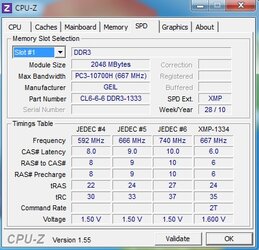Need more info about the ram. CPU-z "SPD" tab would be helpful and please put system info in your "Sig". Please read this:
________________________________________________________________
Welcome to Overclockers Forum!
We enjoy helping others with their questions and with problem solving their issues.
We would also ask, however, that you take some preliminary steps that will make this a lot easier for all of us:
1. Please put your system information in your “sig” so that it displays with every post you make below the post dialog. This will give contributors a quick and easy means of referencing information about your system components. Please include information about:
a. Your CPU make, model and speed
b. Your motherboard make and model
c. Your CPU heatsink/fan (HSF) make and model (OEM stock? Aftermarket?)
d. RAM (memory) make, model and speed
e. Case make and model, width of case (side to side on a tower case), placement and number of cooling fans
f. Power Supply (PSU) make, model and watt rating.
g. Operating system installed
h. Ambient (room) temperature of the computing environment
i. Any other relevant info you think we might need
How do I put this stuff in my “sig” you are probably asking about now? It is simple:
Locate the “quick links” button at the top of the OCForum desktop user interface. It is right below the “Contact” button in the blue tool bar. Click on the drop arrow and choose “Edit Signature” about half way down. Enter the system info and save.
Download and install the following freeware programs that will be used to test settings, temps and stability as we problem solve together:
1. CPU-z (reports information about your hardware and its settings). The program interface displays info under several categorical tabs. For our purposes there are three tabs that are important: “CPU”, “Memory” and “SPD”. We will probably ask you to capture images of the info displayed by these tabs. How to do that is described below.
2. HWMonitor (reports info about your temperatures and voltages)
3. Prime95 (stresses the CPU and all its cores at near 100% capacity). Needed to test for maximum CPU/core temps and to test for stability as you test different settings. It is handy to know that after running Prime95 for 10 min. your will be within about 2c of what your max temps would be when running the stress test for a much longer time. This “10 min.” test saves time in preliminary evaluation of various system setting changes you may make as you experiment. The first time you run Prime it will ask you if you want to “Fold” or “just stress test”. Choose stress testing and the “Blend” option. Monitor your temps with HWMonitor as you run Prime95. It is recommended with newer AMD processors to not allow the core temps to exceed mid 50s C. Intel processors are safe at higher temps than that, 70c or so.
4. A “screen capture” program that will enable you to capture images of the programs above so we can “see what you see”. Windows Vista and Windows 7 have an excellent screen capture tool that comes bundled with the OS called “Snipping Tool” that is located in “Accessories”. It’s a good idea to put it in the quick launch area of your task bar for ready access. If you are using Windows XP you can download freeware screen capture programs for this purpose. The one I use for XP is “MWSnap”.
Please run these programs upon request, capture images of them to your desktop and upload the captured images with your posts. To upload the images with your post:
1. Go to the “Message Window” and choose “Advanced”
2. Go to “Manage Attachments” located below the message window under “Additional Options”. A window pops up to enable you to browse for the image or images.
3. Select “Choose File” button to browse for and select the image file or files to upload.
4. Click “Upload”. You can upload up to three at a time.
5. Close the “Manage Attachments” window.
6. In the message window, type in any remarks you wish to include with the images.
7. Click on “Submit Reply” to post the images and your comments
8. If the images fail to upload it will be because you exceeded the file size limit. You will need to break the upload into more than one post or reduce the size of the images. There are freeware “file downsizer” programs available. The one I use is called “PIXresizer”. Please make the images large enough to easily read the text they contain but not so large they eat up a lot of screen viewing area. This may take some experimenting on your part.
Thanks for your cooperation!










 to OCF!
to OCF!